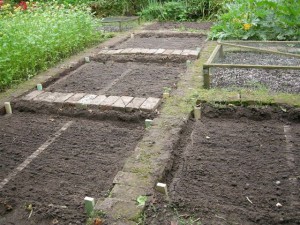The seed corns shown in ‘Many seeds 1’ are not all I harvested this year. Indeed I got about 36690 from 201 different crosses. 26000 seeds were planted very close together, because my heated seed beds are designed for 10000 seed corns . The rest of 10690 shall be planted into the open ground in the end of September.
Because of these numbers you should not doubt my mind. I think I have a light form of yellow fever only. But you are free to see it in another way.
Some hybridizers to come may be interested in my planting method: The heaters in the picture have 100 watts and hold a minimum temperature of 5 degrees C in the first winter. The soil for the seed is 5 cm peach with a low concentration of salt nutrients (in Germany called TKS 1) and 30 percent of perlite. The seeds are powdered with the fungicide ‘Maneb’ and covered with a little soil. I think the higher temperature in the first winter is favorable for crosses of species with each other and of standard daffodils with species. For crosses of standard daffodils sowing in the open ground is possible. The seedlings remain in the beds for three years and are fertilized with a liquid fertilizer during the growing period in intervals of two weeks.
Theo


Hi Brian and Theo and others,
I am very impressed with all the crosses and seed count. Question – how do you arrive at your final seed count – surely not by counting every individual seed? Do you weigh a sample and then calculate? I’d be interested to know.
For my part I make only 100 crosses or less. Very seldom more than one flower of a cross, although usually both ways. Nowadays I check Daffseek to see if the parents are viable and also to check their breeding as well as their descendants. As you know I line breed mostly but also will make a cross if the two flowers look good together.
I would have to say that planting out 36,000 bulblets at two years would be a nightmare – or perhaps you broadcast them. Very interesting – I am pleased and proud that both of you are colleague members of the National Daffodil Society of NZ!
Cheers to all
From a frustrated Peter where the season is now three weeks in advance of “normal”, and whose fridges are now jam packed with flowers and the national is still two weeks away.
=2 width=”100%” align=center tabindex=-1>
Hello All,
The district we live in is sometimes referred to as theKentucky
There is a very real danger as Brian notes of getting too close to inbreeding. However I continue to be interested in pedigrees – otherwise we may as well leave the work to the bees – indeed I collect more open pollinated seed than I should but have never had a result like Queen’s Guard! Damn! And goodness knows that I used Pontes often enough in my crosses.
I agree entirely with Brian’s point on show varieties becoming good garden varieties. Earlier I posted a photo of John Lea’s Loch Loyal and Loch Hope flowering beautifully under trees. Their pedigrees are perfect examples of what can be achieved with line breeding and there is no doubting their vigour.
For those with limited time and ground I still recommend that breeders study pedigrees and establish a line – as Brian notes we are probably doing this unwittingly anyway. But with that wonderful tool of Daffseek we are given the time to check out pedigrees in a split second! And we even have photos to see if the two sets of grandparents look good together!
Flowers continue to rush into bloom. The sun is shining and there will be blooms waiting to be pollinated!
Cheers,
Peter.
=2 width=”100%” align=center tabindex=-1>
Well, I must sheepishly admit that I really do not know a good definition of line breeding. I might have thought I understood, but the recent comments make me wish had I some more exact comprehension of what would distinguish line breeding from inbreeding. If someone has time to post a brief explanation, I’d be most grateful.
Melissa
they meant that his breeder selected the best female puppy each year and bred her to him, bred the best female in that litter back to him, etc.,and he would be on the pedigree as sire for seven generations.. Line breeding would involve outcrosses every so often. I’m told that the puppies were gorgeous, but they spent a lot of time running in small circles.